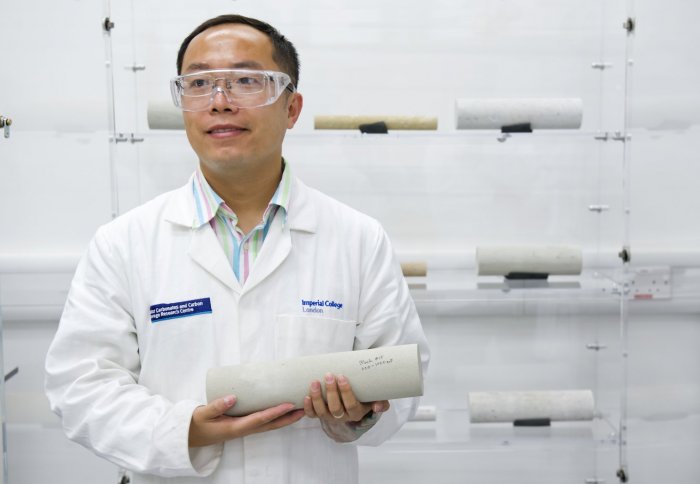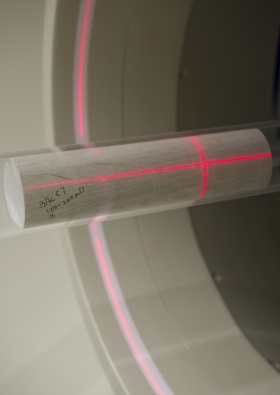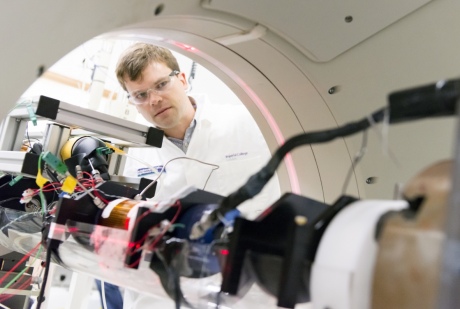Study suggests method is rock solid for storing carbon dioxide deep underground
by Colin Smith

Scientists report that they may have found the best way for trapping carbon dioxide permanently in rocks deep underground.
The research provides more evidence to support Carbon Capture and Storage technology as a viable method to use in the fight against climate change.
Carbon Capture and Storage (CCS) is a method that could enable industry to capture carbon dioxide from power plants before it reaches the atmosphere. It involves pumping carbon dioxide inside rocks deep underground, where it can be stored. One potential method involves replacing salty water trapped inside the microscopic pores of rock with carbon dioxide, a method called capillary trapping. However, previous research suggested that capillary trapping might be less successful at storing carbon dioxide in the types of rocks currently earmarked for their potential as underground reservoirs, such as sandstone and carbonate rocks.

(Left) The researchers recreated the same conditions that occur deep underground and used an x-ray imaging device to see how this affected berea sandstone rock samples.
Scientists from Imperial College London have replicated the capillary trapping process in the lab and experimented on a typical type of sandstone, Berea sandstone, to demonstrate definitively the amount of carbon dioxide that could be stored in the rock’s microscopic pores. The scientists found that 50 per cent of carbon dioxide stays in the immediate vicinity of where it is injected in the rock, with the rest being trapped as it rises further up the layers of rock between the sandstone and the surface. The positive results suggest that capillary trapping has the potential to become the dominant mode of storing carbon dioxide in rock reservoirs in the future.
In the study the team subjected the Berea sandstone to a range of environmental conditions to determine how well the capillary trapping process would fare in the real world. They found that the rock could withstand the enormous pressures and temperatures it was subjected to without losing trapped carbon dioxide. Even the gaseous kind of carbon dioxide, which is generally less easy to trap, stayed securely in the rock.
The team also pumped salty water through the Berea sandstone pores to replicate conditions underground. They sped up the process, pumping water through the rock at a rate that enabled them to simulate what would happen over a 100 year period. The researchers found that even this failed to dislodge the carbon dioxide impregnated through the capillary trapping process.
(Below) Dr Samuel Krevor in the lab inspecting a device they use to hold sandstone core samples during experiments.
 Dr Samuel Krevor, co-author from the Department of Earth Science and Engineering at Imperial College London, said: “Fossil fuels still dominate the global economy and we need technologies that are going to help us to make the transition to a cleaner environment. We feel that our research is important as it demonstrates that capillary trapping could be a highly effective way of storing vast quantities of carbon dioxide in rock. Our findings show that when carbon dioxide is trapped this way there is little risk that it will leak, making it a safe and robust method for carbon dioxide storage, which could help us to tackle climate change.”
Dr Samuel Krevor, co-author from the Department of Earth Science and Engineering at Imperial College London, said: “Fossil fuels still dominate the global economy and we need technologies that are going to help us to make the transition to a cleaner environment. We feel that our research is important as it demonstrates that capillary trapping could be a highly effective way of storing vast quantities of carbon dioxide in rock. Our findings show that when carbon dioxide is trapped this way there is little risk that it will leak, making it a safe and robust method for carbon dioxide storage, which could help us to tackle climate change.”
Berea sandstone is found across America and is similar to many other types of sandstone rocks around the world that could be used for storing carbon dioxide.
The research was carried out in the Qatar Carbonates and Carbon Storage Research Centre Multi-scale Imaging laboratory, which is only one of three laboratories around the world with the ability to observe how carbon dioxide is stored in rocks.
The researchers used a large set of specialised high pressure pumps to circulate fluids through the rock in the same conditions that occurs deep underground in these sandstone rock reservoirs. They used an x-ray imaging device to image the fluids in 3D within the rock core, while carbon dioxide and water were moving through the rock. The researchers also had a large number of sensors to measure the pressure and temperatures throughout the system while the fluids were circulating. This enabled the researchers to control the flow of water and carbon dioxide while imaging the fluids in the rock at elevated pressures, temperatures and water salinities, which are observed deep underground in rock reservoirs.
The next step will see the team characterising the capillary trapping properties of reservoirs around the world that are currently considered good locations for storing carbon dioxide. The aim is to quantify precisely how much carbon dioxide could be contained using the capillary trapping process in each location. In the UK the team is currently testing rocks from the Sherwood sandstone from the Southern North Sea and the East Irish Sea. They are also analysing rocks from target storage reservoirs in Australia and the USA.
The study was published in the journal Water Resources Research.
Article text (excluding photos or graphics) © Imperial College London.
Photos and graphics subject to third party copyright used with permission or © Imperial College London.
Reporter
Colin Smith
Communications and Public Affairs